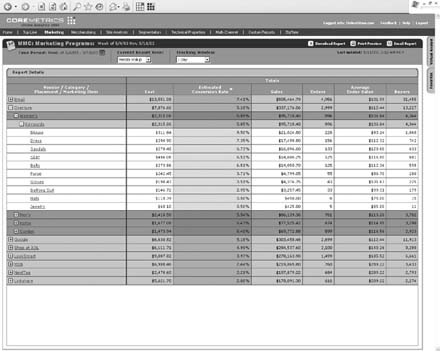Hack81.Know How to Use Retail Analytics
Hack 81. Know How to Use Retail Analytics
While not exactly a class of its own, web measurement for online retailers entails fairly specific uses of the tools and hacks described in this book; knowing how and when to leverage these tools can significantly increase your ability to market, merchandise, and sell. Learning how to use retail web measurement applications may equip you to sustain the double-digit growth you have become accustomed to as an online retailer. Pouring additional dollars into your marketing budget might also do the trick, but web measurement offers an inexpensive and easy way to achieve quick wins that can translate into additional sales, more active customers, and marketing cost savings. Retail web measurement applications leverage most of the web measurement concepts, tools, and hacks you already know; extend a few of these items to better address specific retail scenarios; and apply the resulting measurement approaches and nomenclature to a fairly straightforward set of objectives:
Start with a simple retail web measurement framework that includes the following analyses. Even if you have already performed an analysis of your checkout funnel and managed to increase completion rate by a few percentage points, this hack introduces two additional exercises you can quickly perform to improve your site's ability to attract, convert, and retain customers. 6.2.1. Optimize Your Marketing SpendOptimizing your online marketing spend is an almost failsafe way to drive additional visitor acquisition and site revenue by reallocating marketing dollars to the most efficient marketing channels and programs. If cost savings is your primary goal, you can use this same exercise to identify laggard marketing programs that you no longer need to invest in. You need to optimize your marketing expenditures via tracking and analysis of key data:
Many web measurement vendors generate a report that describes all marketing activity using multiple fields: vendor, channel, campaign, message type, creative format, and URL, for example (Figure 6-1). You can sort the report by each of the retail metrics mentioned above or by a combination of them.
You'd be surprised at how much additional information you can glean simply by sorting columns:
Optimize your marketing spend by aligning your investments with your business goals. By reallocating 30 percent of your online marketing budget to the relationships that drive the most traffic by volume, the most valuable traffic, the highest sales, or the largest order values, you can quickly recover marketing losses and better achieve the specific goals of your retail site. 6.2.2. Analyze Product Placement and Look to BookOn a retail web site, shoppers make a series of decisions before purchasing online. They look for products of interest in the places they most expect to find them. If they find them, they make a near instant judgment of whether the product is presented, described, and priced in a compelling way. Figure 6-1. Breakdown of marketing programs You should leverage your web measurement tool to explore how shoppers make decisions, using the following steps:
Categories with high values for product views but low look-to-book ratios may be attracting shoppers in search of products that they wrongly expect to find. Solve this problem by recategorizing products, placing products in multiple categories, and enhancing site navigation or search. Whatever the root cause, unresolved problems with product placement lead to lost sales and lost potential customers. Analyze specific product performance by looking at abandonment rate and look-to-book ratio at the product level. Products with high abandonment rates may have excessive shipping and handling charges that are revealed only after the product is placed in the shopping cart. Products with high look-to-book ratios may be poorly presented, unattractively priced, or labeled as out of stock. Address problems with poor look-to-book ratios by enhancing site navigation, site search, product imaging and presentation, price, and shipping options. 6.2.3. Streamline the Checkout FunnelA typical checkout sequence includes steps for:
You need to measure each of these attrition points not only in terms of completion or defection, but also by shopping cart value, time to complete, and new versus repeat buyer status [Hack #52]. You can remedy many defection problems by applying web interface usability best practices to key information entry pages, such as registration and address entry. Fortunately, many of these best practices are well understood:
Combined with effective marketing and merchandising analyses, regular optimization of the checkout and registration funnels is the foundation of retail web analytics. Brett Hurt and Eric T. Peterson |
EAN: 2147483647
Pages: 157
